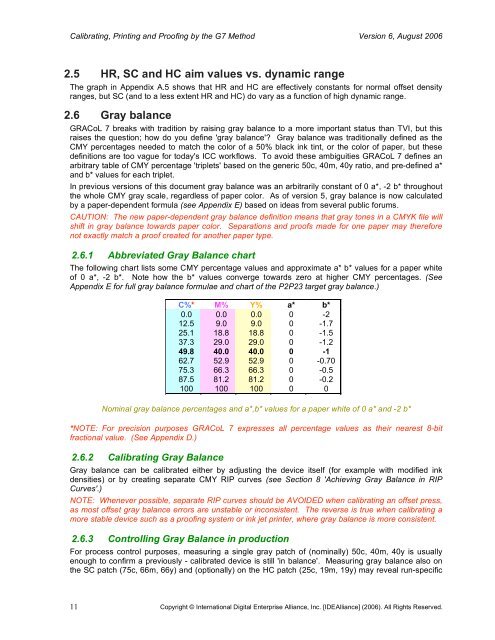Calibrating, Printing and Proofing by the G7™ Method
Calibrating, Printing and Proofing by the G7™ Method
Calibrating, Printing and Proofing by the G7™ Method
Create successful ePaper yourself
Turn your PDF publications into a flip-book with our unique Google optimized e-Paper software.
<strong>Calibrating</strong>, <strong>Printing</strong> <strong>and</strong> <strong>Proofing</strong> <strong>by</strong> <strong>the</strong> G7 <strong>Method</strong> Version 6, August 2006<br />
2.5 HR, SC <strong>and</strong> HC aim values vs. dynamic range<br />
The graph in Appendix A.5 shows that HR <strong>and</strong> HC are effectively constants for normal offset density<br />
ranges, but SC (<strong>and</strong> to a less extent HR <strong>and</strong> HC) do vary as a function of high dynamic range.<br />
2.6 Gray balance<br />
GRACoL 7 breaks with tradition <strong>by</strong> raising gray balance to a more important status than TVI, but this<br />
raises <strong>the</strong> question; how do you define 'gray balance'? Gray balance was traditionally defined as <strong>the</strong><br />
CMY percentages needed to match <strong>the</strong> color of a 50% black ink tint, or <strong>the</strong> color of paper, but <strong>the</strong>se<br />
definitions are too vague for today's ICC workflows. To avoid <strong>the</strong>se ambiguities GRACoL 7 defines an<br />
arbitrary table of CMY percentage 'triplets' based on <strong>the</strong> generic 50c, 40m, 40y ratio, <strong>and</strong> pre-defined a*<br />
<strong>and</strong> b* values for each triplet.<br />
In previous versions of this document gray balance was an arbitrarily constant of 0 a*, -2 b* throughout<br />
<strong>the</strong> whole CMY gray scale, regardless of paper color. As of version 5, gray balance is now calculated<br />
<strong>by</strong> a paper-dependent formula (see Appendix E) based on ideas from several public forums.<br />
CAUTION: The new paper-dependent gray balance definition means that gray tones in a CMYK file will<br />
shift in gray balance towards paper color. Separations <strong>and</strong> proofs made for one paper may <strong>the</strong>refore<br />
not exactly match a proof created for ano<strong>the</strong>r paper type.<br />
2.6.1 Abbreviated Gray Balance chart<br />
The following chart lists some CMY percentage values <strong>and</strong> approximate a* b* values for a paper white<br />
of 0 a*, -2 b*. Note how <strong>the</strong> b* values converge towards zero at higher CMY percentages. (See<br />
Appendix E for full gray balance formulae <strong>and</strong> chart of <strong>the</strong> P2P23 target gray balance.)<br />
C%* M% Y% a* b*<br />
0.0 0.0 0.0 0 -2<br />
12.5 9.0 9.0 0 -1.7<br />
25.1 18.8 18.8 0 -1.5<br />
37.3 29.0 29.0 0 -1.2<br />
49.8 40.0 40.0 0 -1<br />
62.7 52.9 52.9 0 -0.70<br />
75.3 66.3 66.3 0 -0.5<br />
87.5 81.2 81.2 0 -0.2<br />
100 100 100 0 0<br />
Nominal gray balance percentages <strong>and</strong> a*,b* values for a paper white of 0 a* <strong>and</strong> -2 b*<br />
*NOTE: For precision purposes GRACoL 7 expresses all percentage values as <strong>the</strong>ir nearest 8-bit<br />
fractional value. (See Appendix D.)<br />
2.6.2 <strong>Calibrating</strong> Gray Balance<br />
Gray balance can be calibrated ei<strong>the</strong>r <strong>by</strong> adjusting <strong>the</strong> device itself (for example with modified ink<br />
densities) or <strong>by</strong> creating separate CMY RIP curves (see Section 8 'Achieving Gray Balance in RIP<br />
Curves'.)<br />
NOTE: Whenever possible, separate RIP curves should be AVOIDED when calibrating an offset press,<br />
as most offset gray balance errors are unstable or inconsistent. The reverse is true when calibrating a<br />
more stable device such as a proofing system or ink jet printer, where gray balance is more consistent.<br />
2.6.3 Controlling Gray Balance in production<br />
For process control purposes, measuring a single gray patch of (nominally) 50c, 40m, 40y is usually<br />
enough to confirm a previously - calibrated device is still 'in balance'. Measuring gray balance also on<br />
<strong>the</strong> SC patch (75c, 66m, 66y) <strong>and</strong> (optionally) on <strong>the</strong> HC patch (25c, 19m, 19y) may reveal run-specific<br />
11 Copyright © International Digital Enterprise Alliance, Inc. [IDEAlliance] (2006). All Rights Reserved.


